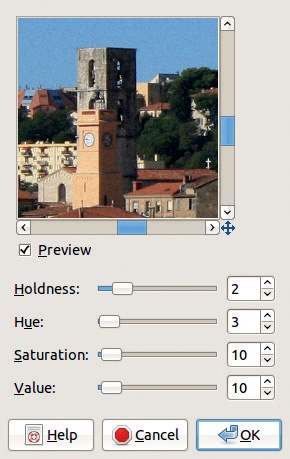In this section, we introduce the common properties of all the filters to avoid repetition in the individual descriptions.
The Filters menu begins with four generic entries. The first two entries allow you to quickly repeat or reshow the last filter used.
The first entry (![]() ) repeats the previous filter with exactly the same parameters. This is very convenient if you’re doing something repetitive that requires multiple applications of the same filter. However, it’s important to note that this command also repeats the last plug-in used, which may or may not be from the Filters menu. For example, pressing
) repeats the previous filter with exactly the same parameters. This is very convenient if you’re doing something repetitive that requires multiple applications of the same filter. However, it’s important to note that this command also repeats the last plug-in used, which may or may not be from the Filters menu. For example, pressing ![]() will repeat Image: Colors > Colorify but not Image: Colors > Desaturate. Colorify is a plug-in; Desaturate is built in to GIMP.
will repeat Image: Colors > Colorify but not Image: Colors > Desaturate. Colorify is a plug-in; Desaturate is built in to GIMP.
The second entry in the Image: Filters menu (![]() ) allows you to reshow the dialog of the previous filter and repeat the filter with different parameters. To see the effect of using the same filter with different parameters, apply the filter, then press
) allows you to reshow the dialog of the previous filter and repeat the filter with different parameters. To see the effect of using the same filter with different parameters, apply the filter, then press ![]() to undo the change, followed by
to undo the change, followed by ![]() to choose new parameters.
to choose new parameters.
The third entry, RECENTLY USED, is a convenient way to access any of the last 10 filters used. As Figure 17-1 shows, some of the filters may be grayed out if they cannot be applied to the current image.
The fourth entry, RESET ALL FILTERS, allows you to set all the filters to their initial state. Most filters have at least one, and often several, parameters, which each have default (initial) values. If you change any of these parameters, the change will be maintained until you quit GIMP or change the parameter again. This is generally convenient, but in some cases you may want to restore the default parameter values for all the filters. Restarting GIMP also restores the parameters to their default values.
Figure 17-2 shows the dialog of the HSV Noise filter, which contains three buttons that are present in all filter dialogs:
HELP brings up the GIMP help documentation for the filter, as explained in 9.6 The GIMP Help System.
CANCEL closes the filter dialog without applying any changes, but the first three entries in the Filters menu will still refer to that filter, even though it was canceled.
OK applies the filter with the current parameter values. Some filters act quickly, while others apply many complex changes that take a long time to process. Pressing
 undoes any filter.
undoes any filter.
Many filter dialogs also contain a preview, which is generally rather small by default. Some dialogs allow zooming in, but even at the maximum zoom, the preview is small. Fortunately, when you enlarge the dialog window, the preview is enlarged as well. The preview is either square or in the same proportions as the image, and the proportions of the preview are always maintained when the window size changes. To enlarge the preview, click and drag a corner of the dialog. If you extend one of the sides of the dialog, the proportions of the dialog change, but the preview will stay the same.
Most of the filter descriptions that follow are accompanied by at least one example. Most examples were created using the settings shown in an associated dialog figure, so often we simply show the example without mentioning the settings, to prevent this lengthy chapter from becoming a separate book.


